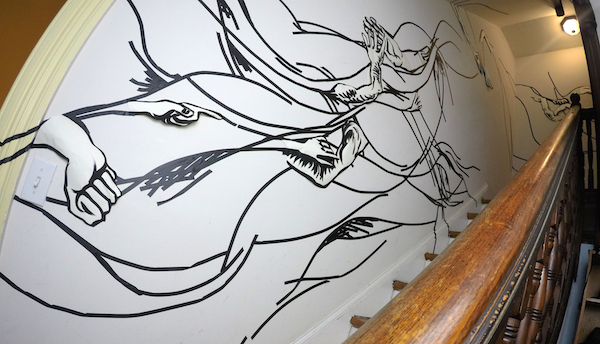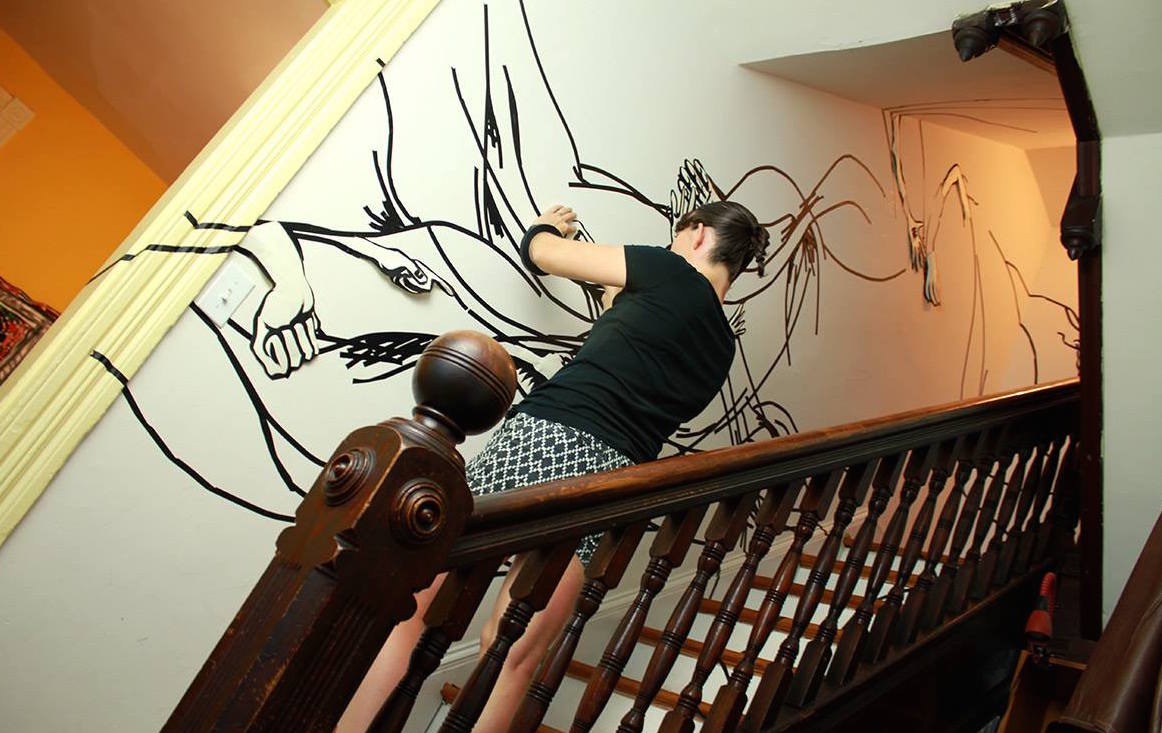Rebecca Juliette Interviews Amanda Burnham
Artists Work is a BmoreArt interview series that explores the work that artists do to make a living while they work on their ‘real work’ – their art.
“I make drawings and drawing installations based on my explorations of and encounters with the city,” explains Amanda Burnham in her artist statement. “Often working on site, outside or in my car, I read the landscape for found fragments of language and record the poetics of vacant lots, moveable type signs, billboards, and rowhouses with ink and other water media on paper. I often piece fragments together in a cumulative manner not unlike the way the urban landscape is collectively authored over time. I expand upon these explorations in my drawing installations by reassembling drawn fragments of landscape with explicit layering and visibly taped and sutured seams. The resulting spaces call to mind their sources while also describing a new landscape vision, forged as the found pieces are adapted to the site against which they have been displaced.”
Burnham’s work has been exhibited widely, including the Volta Art Fair (Basel, Switzerland), the Delaware Center for Contemporary Art, the Aldrich Museum of Contemporary Art, the Toledo Museum of Art, Artisphere, the Urban Institute of Contemporary Art, the Cranbrook Institute of Art, Benrimon Contemporary (NYC), Bridge Gallery (NYC), Christina Ray Gallery (NYC), Dorsch Gallery (Miami) and GV/AS Gallery (Brooklyn, NY). Local venues include the Creative Alliance, School 33, the Silber Gallery, the Julio Art Gallery, the Gormley Gallery, MICA, d center, the Stamp Gallery, Maryland Art Place, Hamiltonian Gallery (DC), and Transformer (DC).
She was an artist in residence at the Embassy of Foreign Artists, Geneva, Switzerland, in 2015 and was the recipient of a Rubys Grant (2014), a Creative Baltimore Fund Award (2014), Individual Artist Awards from the Maryland State Arts Council in 2010 and 2013, and a Sondheim Semifinalist in 2012, 2013, and 2014. A graduate of Harvard University (BA) and Yale University (MFA), Burnham is an Associate Professor at Towson University.
Name: Amanda Burnham
Age: 37
Website: www.amandaburnham.com
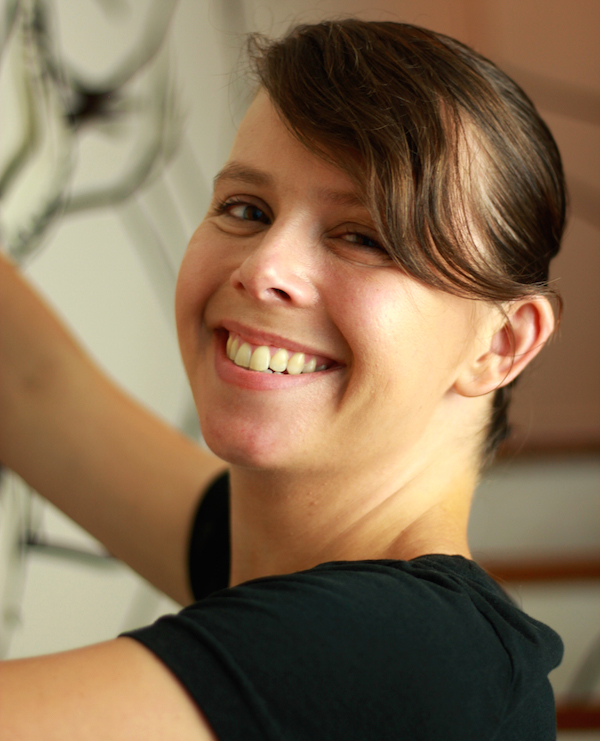
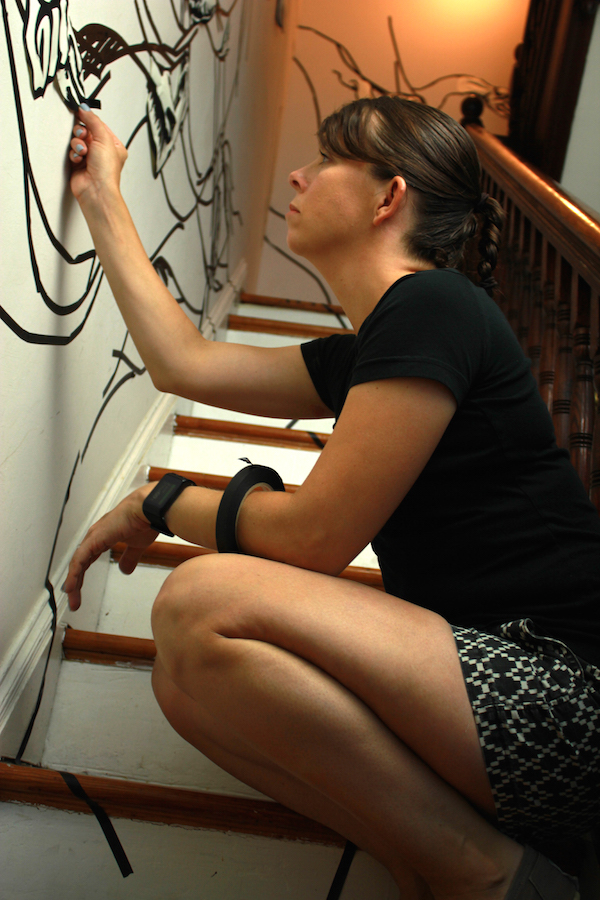
Description of Art You Make:
I make drawings and large, site specific installations which are also drawings. The latter are (usually) composed of quick, gestural acrylic paint sketches made with a fat brush that are then cut and reassembled in three dimensions over the surfaces of a space. The effect is somewhere between a comic book and a stage set. Speaking of which, doing these works as actual sites for performance is something that has long interested me, and I’m delighted to have just such an opportunity now!
I’m creating a responsive installation work for “Broken Bone Bathtub,” a wonderful immersive theater piece by Siobhan O’Laughlin that is being staged by Submersive Productions in a historic Baltimore row home. It’s giving me the chance to collaborate with some of my favorite theater artists (I met Glenn Ricci and Ursula Marcum when they were staging “The Mesmeric Revelations of Edgar Allen Poe” last year and absolutely loved that show – I saw it twice). It’s also presenting me with the very unique opportunity to create a visual work woven within the context of a living home – the piece is not only a response to Siobhan’s performance, but also to the implied narratives of the house itself. Very different from a white cube!
Day Job:
Associate Professor, Towson University Department of Art+Design, Towson, Maryland.
Hours per week at work:
It varies – during the academic year at least 40, distributed irregularly over the week depending on when I have classes or meetings, and with a lot of prep work/emailing at home. During the summer of course it’s a lot less since I’m not teaching.
Hours per week in studio:
It also varies due to the situation described above. During school I try to have at least one dedicated studio day a week at minimum and I try to do a little every day, though it can be hard. Probably about 8 – 15 hours a week. During winter and summer recess I go full steam ahead and work every day – 30 to 40 hours a week.
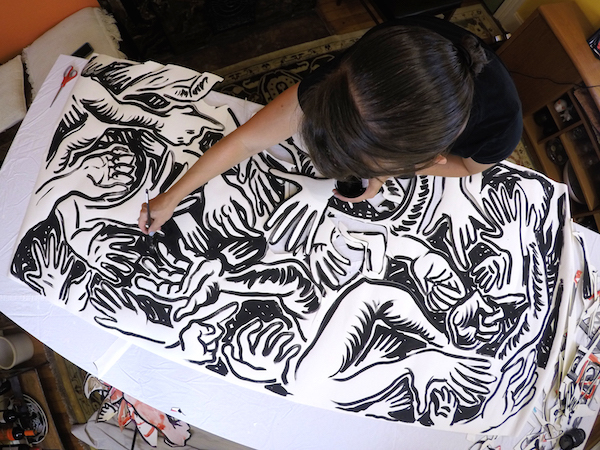

Duties or tasks performed at day job:
I teach all levels of drawing, Senior/BFA project in painting, and sometimes a graduate seminar on teaching or writing about art. I’m the foundations coordinator at Towson, which means I schedule all of our sections for foundations level courses (the ones freshman take before they choose a concentration) and manage/oversee their associated curriculum, facilities, and budget. I am the academic advisor of about 50 undergrads, and I serve on 5 or 6 graduate committees (involves meeting with grad students one on one several times a semester and twice with the whole committee to critique work and help shepherd them through the program).
I also serve on a number of administrative committees, which are the essential unit by which the work of the university is undertaken. Small groups of faculty address things like budget, planning, curriculum, and promotion and tenure at the departmental level, as well as at the college and university level. Ideally you serve on a variety of levels and types of committee over time, and as such have a broad picture of the functioning of the whole university, as well as input into that functioning. One very large “committee” I serve on is the University Senate, which meets once or twice a month. Senate is sort of a nerve center for this vast committee system. As a body it takes up business and, through a process of discussion and debate, identifies and addresses problems, and offers recommendations to administration.
Best thing about your day job:
It’s extremely flexible, and intellectually stimulating.
How does your day job enhance or detract from your studio practice?
It mostly enhances my studio practice since I spend a good deal of my time thinking about making things. I’m brought into dialogue with hundreds of people pursuing hundreds of different creative endeavors and it keeps me thinking divergently about my own work. It also helps that making and showing my own work is actually a requirement of the job and getting tenure – it lights yet another fire under me to keep going.
Favorite job ever:
The one I have now is the best! Though one of my first teaching jobs, which was as a museum educator at MoMA in New York, was really amazing and convinced me that teaching was what I wanted to do forever. It was extremely cool to be in close proximity to MoMA’s vast collections on a daily basis and to get K-12 students excited about looking at and forming opinions about these epic works. Also, my ID got me in for free to any museum in the world, so that was a pretty great perk!
Job you couldn’t wait to leave:
Oddly, working as a an artist’s assistant. I don’t think this is inherently a bad job, but it can be pretty painful if personalities clash. I don’t have an assistant myself and I can’t really imagine having one – the decisions you make when it comes to your own work are obviously so personal and not necessarily efficient or conventionally logical. Bringing another person close to this highly individuated (and high stakes!) process can be an awkward proposition.
Is it your goal to become a full-time artist? Why or why not?
Not really. While it certainly seems appealing at times when the work of the semester is really piling up, whenever I’m able to focus in studio for an extended period of time I inevitably start to get antsy. I don’t love being isolated – I like having outside stimuli. Which is actually how my current work evolved – I kept leaving my studio to draw outside because I just couldn’t stand being cooped up and not hearing other people going about their days. I thrive on the contact with other people that my job provides.
What advice do you have for young artists just out of school, in terms of balancing your work and studio practice?
Make a schedule and stick to it. Put it in your google calendar or whatever you use, and treat it like you’d treat your job – like you’d get fired if you didn’t show up. Don’t feel bad if it’s only a little bit of time each day, just keep the continuity. Make work with what you have, don’t let an inability to afford certain types of supplies be the excuse that keeps you from making. And apply for things. Lots of things. Having real commitments and deadlines absolutely does help not only keep you on track, but keep you psychologically in a state of mind that your work will have a public life and doesn’t just exist in a bubble.

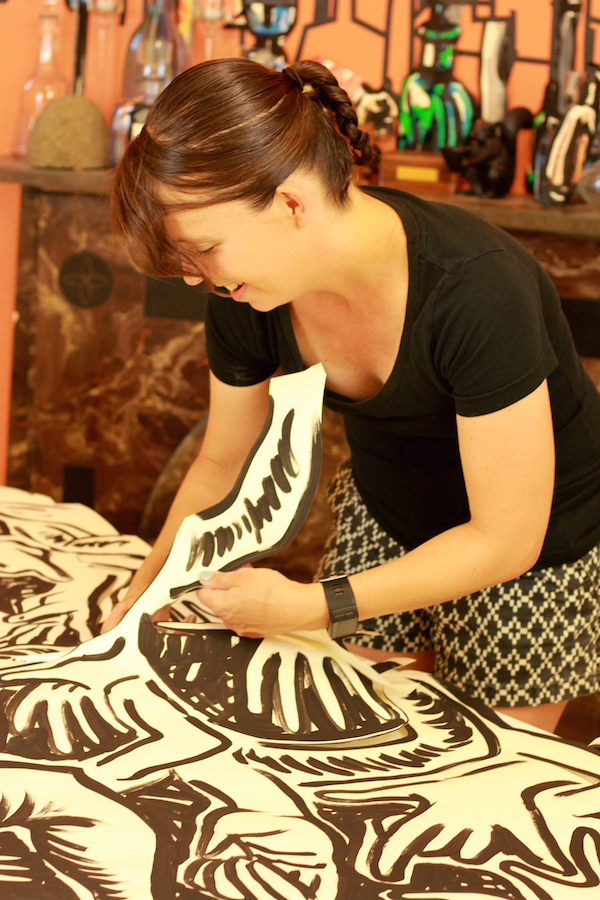
What’s coming up next for you as an artist? What projects are you working on or looking forward to?
Broken Bone Bathtub opens August 19th, and I’m really excited to see how the piece I’m making comes alive in relation to Siobhan’s performance! I just got back from a residency in Shanghai as well, where I was making artist books. One edition is finished and a few more are cooking – I’m hoping to get these out in the world soon. I also have several installation projects to look forward to in the fall, including one at the Berman Museum (at Ursinus College in Pennsylvania).
You can see Amanda’s work at the performance of Broken Bone Bathtub. Friday, August 19th – Sunday, September 4th. More info and tickets here.
